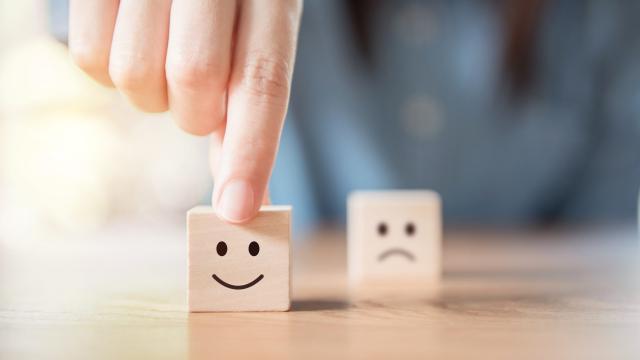Even though you know they’re probably coming from a place, scrolling through your social media feed only to find an onslaught of memes and quote cards instructing us to “Choose Happiness,” or emit “Good Vibes Only” can be maddening. (Or maybe that’s just me and everyone else loves them?) And again, I understand that most people are not militantly enforcing their good-vibes-only policy, and would say that they’re only putting stuff like that out into the world to counteract “of all the negativity out there.”
Great, but seeing that kind of sentiment over and over can be difficult if you’re not in a good place. And right now, in 2020, I’m not sure whether/how anyone is in a good place. That is only one small part of toxic positivity. Here’s more about the concept, and some strategies for dealing with it when it inevitably crops up.
[referenced id=”961431″ url=”https://www.lifehacker.com.au/2020/08/is-it-an-anxiety-disorder-or-just-life-in-2020/” thumb=”https://www.gizmodo.com.au/wp-content/uploads/sites/4/2018/06/womansad_2-300×169.jpg” title=”Is It an Anxiety Disorder, or Just Life in 2020?” excerpt=”Although anxiety and fear are two different things, constantly dealing with fear of uncertainty is something many people with anxiety experience regularly. And for the past six months — amid a global pandemic — almost nothing has been certain. It makes sense that we’re anxious about whether we, or our loved…”]
What is toxic positivity?
There are a bunch of definitions floating around to explain the idea of toxic positivity. One that I think does an excellent job at breaking it down comes from Dr. Jaime Zuckerman, a clinical psychologist, and appears in an article on Healthline:
“Toxic positivity is the assumption, either by one’s self or others, that despite a person’s emotional pain or difficult situation, they should only have a positive mindset or — my pet peeve term — ‘positive vibes.’”
Zuckerman goes on to say that toxic positivity can take many forms, including but not limited to: a friend or family member who scolds you for expressing frustration about something instead of actually listening to why you’re upset; or comments like “look on the bright side,” “be grateful for what you have,” “it could actually be much worse,” “if you stay positive, something good will come your way.” (There are so, so many.)
[referenced id=”937004″ url=”https://www.lifehacker.com.au/2020/08/can-happiness-courses-really-make-you-happier/” thumb=”https://www.gizmodo.com.au/wp-content/uploads/sites/4/2018/04/HAPPINESSS-300×169.jpg” title=”Can Happiness Courses Really Make You Happier?” excerpt=”When Krysta signed up for the UC Berkeley course The Science of Happiness, she didn’t know what to expect. The closest thing she’d done before was a personal development boot camp that had a bit of positive psychology thrown in. But after grappling with a fundamental disagreement in her marriage, she…”]
Why is toxic positivity harmful?
#NotAllPositivity or happy people are engaging in toxic positivity. Genuinely experiencing joy or happiness is wonderful. The problems start when you try to force your positivity on others and it makes them feel worse because they’re experiencing a different emotion that you may be invalidating. That same Healthline article also featured input from Carolyn Karoll, a psychotherapist in Baltimore, that helps break this down:
“The pressure to appear ‘OK’ invalidates the range of emotions we all experience. It can give the impression that you are defective when you feel distress, which can be internalized in a core belief that you are inadequate or weak. Judging yourself for feeling pain, sadness, jealousy — which are part of the human experience and are transient emotions — leads to what are referred to as secondary emotions, such as shame, that are much more intense and maladaptive. They distract us from the problem at hand, and [they] don’t give space for self-compassion, which is so vital to our mental health.”
People who are sad, depressed, grieving, or anything that’s not perceived as happy/pleasant make us uncomfortable, sure. But it is not someone’s responsibility to put on a happy face to make you feel better. And yet again, yes, the positive person is likely coming from a good place where they just want to help. This just isn’t the way to do it.
[referenced id=”934310″ url=”https://www.lifehacker.com.au/2020/07/how-to-stop-being-an-enabler/” thumb=”https://www.gizmodo.com.au/wp-content/uploads/sites/4/2020/07/20/ebhbtpkulkbsei4ubxfc-300×168.jpg” title=”How to Stop Being an Enabler” excerpt=”As children, we’re taught to be helpers. Along with learning how to share, lessons about helping other people start in preschool or earlier. But most of us weren’t taught about healthy boundaries, or when to recognise when “helping” someone else turns into enabling.”]
How to handle toxic positivity
Here are a few strategies for dealing with toxic positivity, for those on both sides of the equation:
- Avoid ignoring or trying to suppress your genuine emotions.
- Listen to and validate other people — even if they’re sad and that makes you uncomfortable.
- Do not offer unsolicited advice.
- Don’t shame anyone (including yourself) for their emotions.
- Remember that feeling bad/sad/negative/not-OK is completely normal, especially during times like these where we’re all trying to process so many things at once.
- You aren’t limited to one emotion at a time. For instance, you can be frustrated and sad about how the pandemic is being handled in this country, but also experience moments of joy FaceTiming with your niece or nephew.
- Be realistic with any sort of timeline. It doesn’t work to set an expiration date for being sad over the loss of a job, for example. Instead, opt for small, actionable steps that could make you feel better, and process things at your own pace.
- Take a break from social media if that would help.

Leave a Reply
You must be logged in to post a comment.